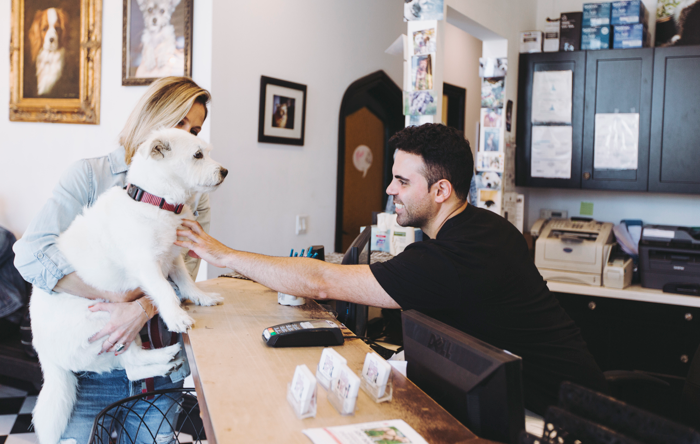
It’s a simple example but one that can be applied to any business. Speaking to people as specifically as possible based on their interests is what’s going to capture and keep their attention. In today’s crowded market, one-size-fits-all messaging that aims to be “everything to everyone” simply doesn’t cut it. In fact, a study by Accenture revealed that 91% of consumers would rather do business with brands that make their shopping experience more relevant.
There are a few proven ways you can split up your market that will allow you to stay relevant with your audience, and it starts with understanding your audience’s core needs and how your business solves them. Once you’ve determined your segments, you can use Ontraport to automatically place people who come into contact with your business on the campaign that best fits them so they receive a personalized experience.
Why you shouldn’t segment by persona
Many marketers develop “avatars” — imaginary characters created based on the common demographics, behavior patterns and goals of a company’s ideal customers — and use those avatars as the basis of their segmentation.
Businesses determine a few avatars that encompass the varying types of customers they serve. For example, a dentist might have an avatar named Lisa, a 40-year-old middle-class soccer mom who is always on the go, lives in the suburbs, and cares about getting her kids’ teeth checked every six months. The dentist might also have an avatar named Taylor, a 30-year-old single female professional who is self-conscious about her smile, as well as an avatar of an 18-year-old who wants to get his or her teeth straightened before heading off to college.
Marketers often use these avatars as the foundation for their outreach — tailoring messaging and entire campaigns around which persona they’re aiming to reach. Sales teams often categorize their leads by avatar after their first phone conversation and determine their follow-up based on it.
This kind of segmentation can be helpful; having real-life personalities to pretend you’re speaking to can help teams narrow their focus and better serve their audiences, but it doesn’t quite go deep enough. What about the 30-year-old male professional who’s self-conscious about his smile? Or the 40-year-old woman who never could afford braces and now wants them? Or the 60-year-old man whose teeth have become yellow from smoking and wants to whiten his teeth?
The point is, their age, gender, occupation, marital status and other demographic information doesn’t quite matter; what everyone who comes to your business has in common is a specific interest or need — a pain point — that you can solve.
Those pain points are how you can and should segment your audience. In the case of the dentist, he’d have a segment for those interested in teeth whitening, a segment for those interested in teeth straightening, and a segment for those simply wanting a reliable check-up every six months.
“Talk to leads about their problems, and make a compelling argument for how you’re going to improve their life,” Ontraport CEO Landon Ray said.
It doesn’t matter what industry you’re in. If you can show prospects that you’re able and willing to solve their problems, that’s far more compelling than speaking to them as if they fit into a specific stereotype that you’ve created.
The better route: segmenting by pain point
The first step to segmenting based on pain points is to step back and consider the true outcomes your customers experience from each of your products or services. What problem are you solving for them, and how are you making their lives better? What are their goals with each product or service?
It’s important to get specific. You may solve similar problems across a variety of products, and it would be tempting to bunch many products under one pain point, but going a level deeper will garner better results.
Going back to the example of the dentist, even though many people in his audience experience the pain point of feeling self-conscious about their smile, the source of their self-consciousness is different for each. The teeth whitening group doesn’t like their yellow teeth, while the other group doesn’t want crooked teeth. Although the dentist could kill two birds with one stone by speaking to both audiences about improving their smile, he’d have a much better chance of resonating with people if he separated them. His messaging, images, offers and positioning would all be precisely related to what the people in each audience can relate to — the first step in building a relationship with a new prospect.
In the case of the dentist as well as with many other businesses, often the easiest way to find your segments is to align them with the products you offer — your products become your segments.
Putting your segments to work
 Once you’ve determined your segments based on pain points you solve or products you offer, you can incorporate them into your marketing strategy by creating campaigns for each one.
Once you’ve determined your segments based on pain points you solve or products you offer, you can incorporate them into your marketing strategy by creating campaigns for each one.
Every asset within each campaign will be tailored to that segment: Your ads that draw them to your opt-in pages, the content and offers on your opt-in pages, the offer email sequences you send, the sales pages where you encourage them to purchase, the follow-up upsell offers you send, and even the referral requests you make will all be written, designed, and positioned in a way that speaks directly to the interests of that segment only.
Remember, it doesn’t matter that you also offer numerous other products — this audience only cares about one of them, and your chances of selling that one product to them is much better if you hyperfocus on it. Once you resolve the pain point they came to you with, you can introduce them to other, related products and services.
Filling your segments with the right contacts
Splitting up your leads based on their problems is a great way to enhance your customer relationships, but how do you know which segment each contact belongs in?
You can make sure contacts get added to the appropriate campaign for their specific interests early on with a variety of forms and tracked custom URLs that capture information. Because the information from your forms and custom URLs sync with your CRM database, and the information in your CRM is what triggers automated follow-up, these tools are your conduit to segmenting your customers and placing them on the right automated customer journey.
Collecting the exact data you need is easier than ever with custom form fields and UTM variables. With CRMs such as Ontraport, you have the flexibility to create your own fields which can then be used as a tool for segmenting your contact list. Likewise, custom tracked URLs allow you to segment site viewers by a variety of behaviors and interests that you otherwise wouldn’t have access to.
Here are just six examples of how you can gather valuable information about your leads from the start, depending on the strategies you use during the attract and convert stages of your campaigns so that you can segment them appropriately.

1. UTMs on ads
When leads click on your ads, you can learn a lot about them: what overall topic they’re interested in, the platform they clicked on your ad from, which ad within your campaign piqued their interest, and more. Including UTM variables at the end of the URLs in your ads allows you to capture that information so that you can continue targeting these new leads with the most relevant info and offers.
For example, a catering company might handle weddings, business events and birthday celebrations. To account for the differences between each type of customer, the caterer might create separate campaigns for each and segment his new leads by campaign — one of the many variables in the UTM. This way, anyone who clicks on a link with a UTM variable corresponding to the weddings campaign would become part of the weddings segment for retargeting.
The catering company could also create segments based on leads who came in from a particular platform or who viewed a particular article, both of which are also variables detectable by UTMs. All you need to do is make sure every ad you launch has a UTM at the end of its linked URL.
2. Blog visit category
If you’re like many modern business owners, you’ve likely spent time creating free blog content to attract leads to your brand. As a veterinarian might cater separately to cat, dog and bird owners, your blog is probably broken into categories based on your company’s different products or services.
When leads click on an article in one of your categories, it tells you important information about them: They’re interested enough in that topic to read an article about it. You can segment unknown leads based on the category of the page they visit and retarget them with related content, similar to how you would with the UTM information from ad clicks.
Another way to segment based on blog visits is to use a pop-up form that displays after the visitor has been viewing an article for a certain period of time. The form might be an offer to opt in for your weekly email newsletter or a free guide on the topic. Once the visitor submits the form, the information creates a new contact record in your CRM with an automatic tag denoting the person’s category interest. Using the vet example, a reader who fills out a pop-up form while reading an article about cats will be tagged with an interest in cats. The tag and form fill-out serve as the trigger for the lead to be added to the corresponding campaign and onto the automated follow-up path you’ve created.
3. Landing page visits using wildcard tracking
Beyond segmenting based on blog page visit, you can segment based on any landing page visit using wildcard characters and rules in Ontraport. A wildcard character is simply a character such as an asterisk (*) that you add to a URL to capture all visits to any subdomain related to the URL.
For example, if a used car dealership segments customers based on which car brand they’re interested in, they could set up a rule so that anyone visiting any of the company’s URLs including cardealer.com/honda/* are added to the Honda campaign and anyone visiting URLs with cardealer.com/audi/* are added to the Audi campaign, and so on.
4. Qualifying question on opt-in form
When leads fill out an opt-in form to access your gated content, consultations, webinars and more, you gain important information about their interests depending on which page they’re on. However, you can hone in on their exact interests or problems using a qualifying question.
Qualifying questions are usually framed around the biggest challenge leads are trying to solve. A physical therapist, for example, might make her question, “What are you trying to treat?” The drop-down answers could include back/neck pain, muscle strains, sciatica, knee or ankle sprains, and overuse injuries. By gathering this qualifying information about potential patients, the physical therapist can accurately segment new leads and send them relevant offers.
The same can be applied in your business. All you have to do is come up with a question and answers that would effectively match up with your segments, and create a drop-down field in your opt-in page for them. Leads’ selection and form submission triggers them being added to the appropriate campaign.
5. Internal forms for sales and customer service teams
If you have a live sales team who does phone or video consultations with clients, much of the information they learn about leads is discovered “offline.” Rather than asking your prospects to fill out a webform repeating the same information they just told you verbally, your sales team can recap the call using internal forms you create in Ontraport.
Once your reps enter the information from the call, it automatically updates that contact’s record in your CRM (or creates a record if one doesn’t exist yet). For example, let’s say a car salesperson just got off the phone with a lead. This particular lead stated on the phone that he is interested in buying a brand new car. He wants to keep the price under $40,000; it needs to be a black or white SUV, and he is available next week to see the top candidates in person.
From there, the salesperson can fill out an internal form that has custom fields for the lead’s level of interest (cold, lukewarm, hot), new vs. used car, price range, specs about the car (make, model, color, etc.), and whether an invitation should be sent to the lead for a showing. This allows automation to be triggered based on data fields in the same way any form fill-out would. If the car dealership segments by new vs. used cars, the contact would be placed on the new car campaign.
6. Referral source
Earning referral is a sure sign that you’ve found and impressed the right type of brand advocates for your target market. By giving each referrer unique referral IDs to add to links they share to promote your brand, you can determine the referrers each new lead came from and segment the leads accordingly. 
For example, the caterer might have multiple wedding planners who refer brides, multiple corporate event planners who refer companies, and multiple event planners who refer parents for kids’ birthdays. You could automatically add leads to the appropriate campaign — for wedding, corporate event, or birthday catering — based on the referral code associated with the link the lead came from. Anyone coming from the referral IDs matching your wedding planner partners would be added to the wedding catering campaign, for example.
Regardless of the strategy you use to place contacts into the right segments, you can rest assured that once they’re on the appropriate campaign, they’ll be sent on a dynamic path that continues to show that you understand their needs. After all, you wouldn’t send your cat-loving friend a 15-second clip of a sandy pup struggling to stay awake after a trip to the beach. Read the room, and your audience will feel much more understood by you, form a significantly stronger attraction to your products, and gain a higher level of trust in you than if you were to speak to them in a one-size-fits-all manner.
